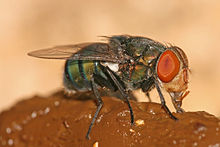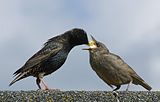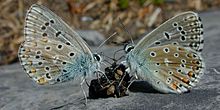- Coprophagia
-
 A female Oriental Latrine Fly (Chrysomya megacephala) feeds on animal feces.
A female Oriental Latrine Fly (Chrysomya megacephala) feeds on animal feces.
Coprophagia or coprophagy is the consumption of feces, from the Greek κόπρος copros ("feces") and φαγεῖν phagein ("to eat"). Many animal species practice coprophagia as a matter of course; other species do not normally consume feces but may do so under unusual conditions. Coprophagy refers to many kinds of feces eating including eating feces of other species (heterospecifics), other individuals (allocoprophagy), or its own (autocoprophagy), those once deposited or taken directly from the anus.[1]
Contents
In plants and animals
Some carnivorous plants, such as pitcher plants of the genus Nepenthes, obtain nourishment from the feces of commensal animals.
Coprophagous insects consume and redigest the feces of large animals. These feces contain substantial amounts of semi-digested food (herbivores' digestive systems are especially inefficient). The most notable feces-eating insect is the dung-beetle and the most common is the fly.
Pigs, like the above insects, will eat the feces of herbivores that leave a significant amount of semi-digested matter, including their own. In certain cultures it was common for poor families to collect horse feces to feed their pigs. However, allowing domestic pigs to consume feces contributes to the risk of parasite infection.
Cattle in the United States are often fed chicken litter due to the high amount of protein and low cost of the feed versus other sources of protein. It has been reported that this process is safe in regards to bacteria loading by heating the chicken litter to 160 °F (71 °C) prior to consumption. There are, however, concerns that the practice of feeding chicken litter to cattle could lead to Bovine spongiform encephalopathy (mad-cow disease) because of the crushed bone meal in chicken feed. The U.S. Food and Drug Administration regulates this practice by attempting to prevent the introduction of any part of a cow's brain or spinal cord into livestock feed.[2] Other countries, like Canada, have banned chicken litter for use as a livestock feed.
Capybara, rabbits, hamsters and other related species do not have a complex ruminant digestive system. Instead they extract more nutrition from grass by giving their food a second pass through the gut. Soft fecal pellets of partially digested food are excreted and generally consumed immediately. Consuming these cecotropes is important for adequate nutritional intake of Vitamin B12. They also produce normal droppings, which are not eaten.
Young elephants, pandas, koalas, and hippos eat the feces of their mothers or other animals in the herd to obtain the bacteria required to properly digest vegetation found on the savanna and in the jungle.[3] When they are born, their intestines do not contain these bacteria (they are completely sterile). Without them, they would be unable to obtain any nutritional value from plants.
Gorillas eat their own feces and the feces of other gorillas. Similar behavior has also been observed among chimpanzees. Such behavior may serve to improve absorption of vitamins or of nutritive elements made available from the re-ingestion of seeds.
Hamsters, guinea pigs and chinchillas eat their own droppings, which are thought to be a source of vitamins B and K, produced by bacteria in the gut. Apes have been observed eating horse feces for the salt content. Monkeys have been observed eating elephant feces. Coprophagia also has been observed in the naked mole rat.
Cat mothers are known to eat the feces of their newborn kittens during the very earliest phase after birth, presumably to eliminate cues to potential predators and to keep the den clean.
Both domesticated and wild mammals are known to consume feces. In the wild they either bury or eat waste to protect their trail from predators. In species of cats, the dominant feline openly displays feces. In domesticated mammals, choosing not to offend the dominant owner, they eat or more prominently bury waste.
In dogs
Coprophagia is a behavior often observed in dogs. Hofmeister, Cumming, and Dhein (2001) wrote that this behavior in dogs has not been well-researched and prepared a study.[4] In a preliminary paper, they write that there are various hypotheses for this behavior in canines, although none have been proven:
- Dogs are, by nature, scavengers, and this might be within the range of scavenger behavior.
- Dogs might want attention from their caretakers.
- They might have anxiety or stress.
- To clean up in crowded surroundings
- They had been punished for having defecated in the past, and attempt to clean up out of fear of being punished again.
- They may be trying to prevent the scent from attracting predators.
- The texture and temperature of fresh feces approximates that of regurgitated food, which is how mothers in the wild provide solid food to their pups.
- Feces (particularly cat feces) contain protein; overfeeding can also increase the quantity of undigested matter in the feces.
- The coprophagia may be due to assorted health problems, including:
- Pancreatitis
- Exocrine Pancreatic Insufficiency
- Intestinal infections
- Food allergies, leading to malabsorption
- The dogs might be hungry, such as when eating routines are changed, food is withheld, or nutrients are not properly absorbed.
- Carnivores may sometimes eat or roll in the feces of their prey to ingest and exude scents that mask their own.
Another hypothesis is that dogs want to investigate the diet of their opponents and get more acquainted with their smell.
Some veterinarians recommend adding pineapple to dog food, as this makes the feces taste excessively bad to dogs. Several companies produce food additives that can also be added to the animal's food to make feces taste bad. Often, these food additives will contain Capsicum Oleoresin, which gives off a repugnant odor, making the fecal matter undesirable to the dog.
In human beings
Sexual aspects
Some coprophiles engage in this practice. Psychiatrists using the classification system of the DSM-IV would consider this a symptom of the paraphilia called coprophilia "if the behavior, sexual urges, or fantasies cause clinically significant distress or impairment in social, occupational, or other important areas of functioning". Coprophagia is also depicted in pornography, usually under the term scat (from scatology).[5]
Medical aspects
Centuries ago, physicians used to taste their patients' excretions, to better judge their state and condition.[6]
Fecal bacteriotherapy is when feces from a close relative or spouse are given to patients suffering from intractable diarrhea caused by Clostridium difficile. The purpose is to repopulate the intestines with the normal gut flora (intestinal bacteria) to decimate the clostridium. The healthy stool is administered by nasogastric tube, enema, or in a capsule.
Consuming other people's feces carries the risk of contracting diseases and bacteria spread through fecal matter, such as E. coli, Hepatitis A, Hepatitis E, pneumonia, polio, and influenza. Coprophagia also carries a risk of contracting intestinal parasites.
Lewin (2001) reports that "... consumption of fresh, warm camel feces has been recommended by Bedouins as a remedy for bacterial dysentery; its efficacy (probably attributable to the antibiotic subtilisin from Bacillus subtilis) was confirmed by German soldiers in Africa during World War II."[7] The introduction of foreign bacteria into the human GI tract via infusion of fecal enemas is, moreover, an established medical practice in cases of ulcerative colitis, especially where the patient's own intestinal flora has been significantly depleted by antibiotic therapy applied for other maladies.[8]
From the psychiatry literature, coprophagia has been observed in a small number of patients with schizophrenia,[9] depression,[10] and pica.[11]
In literature
- François Rabelais, in his classic Gargantua and Pantagruel, often employs the expression mâche-merde or mâchemerde, meaning shit-chewer. It is in turn a citation of the Greek comedians Aristophanes and particularly Menander, which often use the term skatophagos (σκατοϕάγος).[12] In one dialogue, Rabelais speaks of coprophagia as a Christian gesture, saying that monks swallow the shit of the world, that is the sins, and for this they are ostracized by society.[13]
- Thomas Pynchon's award winning novel Gravity's Rainbow, contains a very detailed scene of coprophagia.[14]
- In the novel Jurassic Park, Procompsognathus (i.e. "compys") consume the excrement of sauropods and in doing so help keep the park clean.[15]
- The 120 Days of Sodom, a novel by the Marquis de Sade, is replete with detailed descriptions of erotic sadomasochistic coprophagia.[16]
- Consider Phlebas, a novel by Iain M Banks contains depictions of a tribe known as the Eaters, who repeatedly engage in Coprophegia
See also
Notes
- ^ Hirakawa, H. 2001. " Coprophagy in leporids and other mammalian herbivores" Mammal Review, Volume 31, Number 1, pp. 61-80(20)
- ^ FDA Urged to Ban Feeding Chicken Litter to Cattle, 2009-11-02, L.A. Times
- ^ [1]
- ^ Hofmeister, Erik, Melinda Cumming, and Cheryl Dhein (2001). Owner Documentation of Coprophagia in the Canine. Archived from the original on 2007-04-27. http://web.archive.org/web/20070427142031/http://www.vetmed.wsu.edu/pets/_archive/study.htm. Accessed November 17, 2005.
- ^ Holmes, Ronald M.. Sex Crimes: Patterns and Behavior. Thousand Oaks: Sage Publications. pp. p. 244. ISBN 0761924175. OCLC 47893709.
- ^ notes to The Works of Francis Rabelais, Volume II, Volume 2, p. 56
- ^ Lewin, Ralph A. (2001). "More on Merde". Perspectives in Biology and Medicine 44 (4): 594–607. doi:10.1353/pbm.2001.0067. PMID 11600805.. The quotation was found by Google Scholar here.
- ^ Treatment of Ulcerative Colitis Using Fecal Bacteriotherapy.
- ^ Harada KI, Yamamoto K, Saito T. (2006). "Effective treatment of coprophagia in a patient with schizophrenia with the novel atypical antipsychotic drug perospirone". Pharmacopsychiatry 39 (3): 113. doi:10.1055/s-2006-941487. PMID 16721701.
- ^ Wise, T.N., and R.L. Goldberg (1995). "Escalation of a fetish: coprophagia in a nonpsychotic adult of normal intelligence". J. Sex Marital Ther. 21 (4): 272–5. PMID 8789509.
- ^ Rose, E.A., Porcerelli, J.H., & Neale, A.V. (2000). "Pica: Common but commonly missed". The Journal of the American Board of Family Practice 13 (5): 353–358. PMID 11001006.
- ^ Rabelais, Book 1, ch. 40 and Book 3 chap. 25
- ^ Rabelais, Book 1, ch. 40 quote: "ilz mangent la merde du monde, c'est à dire, les pechez"
- ^ Thomas Pynchon (1973) Gravity's Rainbow, Part 2, episode 4.
- ^ Procompsognathus at the Jurassic Park Wiki
- ^ le Marquis de Sade (1785) Les 120 journées de Sodome, ou L'École du Libertinage
External links
- King County, Washington, Animal Control Section. "Eating His Own or Other Animal Feces."
- Coprophagia in Dogs (ASPCA's Virtual Pet Behaviorist)
- Why Does My Dog Eat Feces? - Theresa A. Fuess, Ph.D, College of Vet Medicine
- Coprophagia: Effective Treatment for Dogs Eating Feces
- Coprophagia in the Canine - Erik Hofmeister; Melinda Cumming, DVM PhD; Cheryl Dhein, DVM, MS, DACVIM; Douglas Island Veterinary Service; detailed preliminary results of study of behavior and prevention in dogs
- [2]
- Break.com - Video of Coprophagia by a Gorilla
- Yesterday's Food Will Become Tomorrow's Food Dr David Ryde MB BS FRCP
Feeding behaviours Carnivores adultHematophagy · Insectivore · Lepidophagy · Man-eater · Molluscivore · Mucophagy · Myrmecophagy · Ophiophagy · Piscivore · Avivore · Spongivore · Vermivore · Herpetivorereproductivecannibalistic
Herbivores Others Methods Apex predator · Bait balls · Bottom feeding · Browsing · Feeding frenzy · Filter feeding · Grazing · Hypercarnivore • Intraguild predation · Kleptoparasitism · Scavenging · TrophallaxisPredation · Antipredator adaptation · Carnivorous plant · Carnivorous fungus · Carnivorous protist · Category:Eating behaviorsCategories:- Dog health
- Dog training and behavior
- Eating behaviors
- Feces
- Greek loanwords
- Pica (disorder)
Wikimedia Foundation. 2010.


